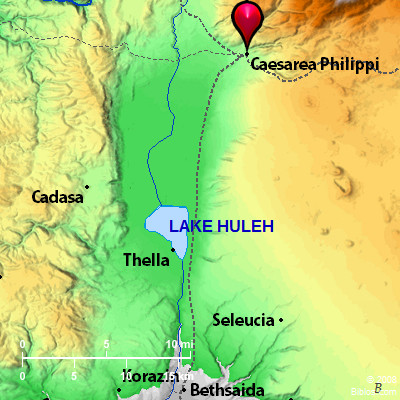Encyclopedia CAESAREAses-a-re'-a, se-za-re'-a (Kaisareia):
(1) Caesarea Palestina (pal-es-ti'na).
The ancient name in the Arabic form Qaisariyeh still clings to the ruins on the sea shore, about 30 miles North of Jaffa. It was built by Herod the Great on the site of Strato's Tower (Ant., XIII, xi, 2; XV, ix, 6), and the name Caesarea Sebaste was given it in honor of Augustus (ibid., XVI, v, 1). With his usual magnificence Herod lavished adornments on the city. He erected sumptuous palaces and public buildings, a theater, and amphitheater with prospect to the sea; while a spacious system of sewers under the city secured cleanliness and health. But "the greatest and most laborious work of all" was a magnificent harbor "always free from the waves of the sea," which Josephus says was not less than the Piraeus: this however is an exaggeration. It was of excellent workmanship, and all the more remarkable because the place itself was not suitable for such noble structures. The whole coast line, indeed, is singularly ill-fitted for the formation of harbors. The mighty breakwater was constructed by letting down stones 50 x 18 x 9 ft. in size into twenty fathoms deep. The mole was 200 ft. wide. Part was surmounted by a wall and towers. A promenade and dwellings for mariners were also provided. The work was done in ten or twelve years. It became the residence of the Roman procurator. It passed into the hands of Agrippa I; and here he miserably died (Acts 12:19, 23). Here dwelt Philip the Evangelist (Acts 8:40; Acts 21:8). To Caesarea Peter was sent to minister to the Roman centurion Cornelius (Acts 10). Thrice Paul passed through Caesarea (Acts 9:30; Acts 18:22; Acts 21:8); hither he was sent under guard from Jerusalem to escape danger from the Jews (Acts 23:23); and here he was imprisoned till his final departure for Rome.
Riots between Gentiles and Jews in Caesarea gave rise to the war (BJ, II, xiii, 7;. xiv, 4). Terrible cruelties were practiced on the Jews under Felix and Florus. Here Vespasian was hailed emperor by his soldiers. Titus here celebrated the birthday of his brother Domitian by setting 2,500 Jews to fight with beasts in the amphitheater. Eusebius was bishop of Caesarea (313-40 A.D.). In 548 A.D. a massacre of the Christians was organized and carried out by the Jews and Samaritans. The city passed into Moslem hands in 638. In the time of the Crusades it fell, now to the Christians and now to the Moslems; and was finally overthrown by Sultan Bibars in 1265 A.D.
The cathedral stood on the site of a temple built by Herod, where the ruins are seen today; as are also those of two aqueducts which conveyed water from Nahr ez-Zerqa. The landward wall of the Roman city was nearly 3 miles in length.
(2) Caesarea Philippi (fi-lip'-i) (Kaisareia he Philippou).
At the Southwest base of Mt. Hermon, on a rocky terrace, 1,150 ft. above sea-level, between Wady Khashabeh and Wady Za`areh, lie the ruins of the ancient city. It was a center for the worship of Pan: whence the name Paneas, applied not only to the city, but to the whole district (Ant., XV, x, 3). It is possible that this may have been the site of ancient Baal-hermon; while Principal G. A. Smith would place Daniel here (HGHL, 480). The district was given by Augustus to Herod the Great 20 B.C., by whom a temple of white marble was built in honor of the emperor. Paneas formed part of the tetrarchy of Philip. He rebuilt and beautified the town, calling it Caesarea as a compliment to Augustus, and adding his own name to distinguish it from Caesarea on the coast of Sharon (Ant., XVIII, ii, 1; BJ, II, ix, 1). From Bethsaida Jesus and His disciples came hither, and on the way Peter made his famous confession, after which Jesus began to tell them of His coming passion (Matthew 16:13 Mark 8:27). Some think that on a height near Caesarea Philippi Jesus was transfigured. See TRANSFIGURATION, MOUNT OF. Agrippa II renamed the town Neronias (Ant., XX, ix, 4). The ancient name however outlived both Caesare a and Neronias, and survives in the Arabic form Banias. The modern village, built among the ruins, contains 350 inhabitants. The walls and towers of which the remains are seen date from Crusading times. The castle, ec-Cubeibeh, crowns the hill behind the town, and must have been a place of strength from the earliest times. Its possession must always have been essential to the holding of the valley to the west. Immediately to the north of the town, at the foot of a steep crag, the fountain of the Jordan rises. Formerly the waters issued from a cave, Magharet ras en-Neba`, "cave of the fountain head," now filled up with debris. Two niches cut in the face of the rock recall the idolatries practiced here in olden times. A shrine of el-Khudr stands on the west of the spring. With the rich soil and plentiful supplies of water, in a comparatively temperate climate, average industry might turn the whole district into a garden. As it is, the surroundings are wonderfully beautiful.
W. Ewing |




